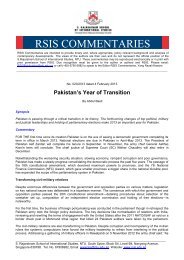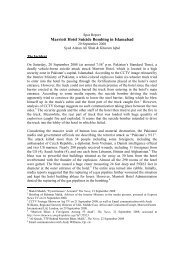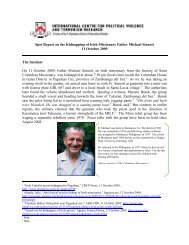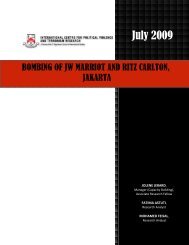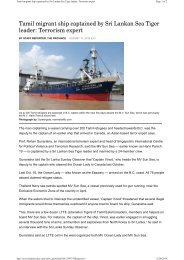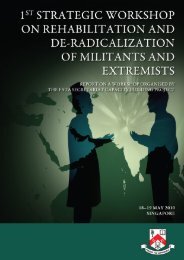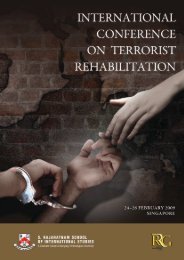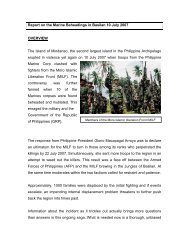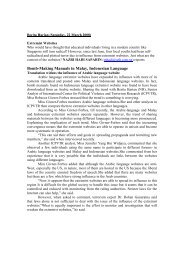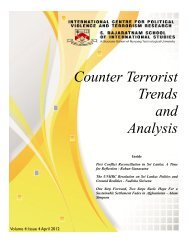Peace and Security Review, Vol.1 No. 2 - International Centre for ...
Peace and Security Review, Vol.1 No. 2 - International Centre for ...
Peace and Security Review, Vol.1 No. 2 - International Centre for ...
Create successful ePaper yourself
Turn your PDF publications into a flip-book with our unique Google optimized e-Paper software.
Badrul A. Khan South Asia <strong>and</strong> Regionalism 91<br />
most South Asian states apart from India lack “any established bourgeoisie<br />
hegemony” (Cox, 1987: 218) <strong>and</strong> hence remains politically vulnerable to nondemocratic<br />
<strong>and</strong> dictatorial rule.<br />
It however seems paradoxical that despite deep asymmetry no hegemonic<br />
power has come to exist in South Asia. This has negatively impacted on<br />
regionalisation because initiating <strong>and</strong> maintaining economic <strong>and</strong> political<br />
institutions, designed to deliver collective good have faced significant obstruction.<br />
India’s long held policy of non-alignment <strong>and</strong> refusal to commit to a<br />
policy of engagement with either of the super powers during the cold war<br />
have contributed to this keeping India oblivious to regional need. This had<br />
also provided a leeway <strong>for</strong> other regional powers particularly China to cash<br />
in <strong>and</strong> exert its influence over those countries.<br />
Although South Asia has become one of the key areas of the world<br />
system since the disintegration of the Soviet Union in 1991 <strong>and</strong> the abrupt<br />
end it brought to the politics of cold war, as the backwater of global politics it<br />
is turning into a site of great game involving the USA <strong>and</strong> China. This has<br />
been made possible by the USA ⎯ India strategic partnership that materialised<br />
after a dramatic shift in USA policy towards India. India-USA alliance<br />
will fail to involve other regional countries in all major issues that concern<br />
<strong>and</strong> influence global politics such as the issues of Islamic militancy, nuclear<br />
<strong>and</strong> missile proliferation; global trade <strong>and</strong> drugs, illicit arms <strong>and</strong> human<br />
migration. However, the prospect of regionalism in the longer term is not too<br />
gloomy. One example of liberal pragmatism is the SAFTA signed in<br />
Islamabad at the 12 th Summit meeting in 2004. The implementation of the<br />
Free Trade Agreement may still be sketchy on how it will overcome the nontariff<br />
barriers <strong>and</strong> trade documentation issues but it has the potential to bring<br />
profound change into areas of trade, finance <strong>and</strong> indeed regionalisation.<br />
References<br />
Ahmad, Qazi, K. 2007. “Towards an inclusive globalisation,” in The Daily Star, 11<br />
January.<br />
Ayoob, Mohammed. 1999. “From regional system to regional society: exploring key<br />
variables in the construction of regional order.” Canberra, Department of <strong>International</strong><br />
Relations, The Australian National University, Fiftieth Anniversary Lecture, April.<br />
Balibar, E. 2002. “What is border?” in Politics <strong>and</strong> the other Scene. New York: Verso,<br />
pp. 75-85.<br />
Batra, N.D. 2006. “Manmohan Singh: Nucelar deal takes an initial step,” in Asia Media, 4<br />
October.<br />
<strong>Vol.1</strong>, <strong>No</strong>.2 2008 pp.77-93




